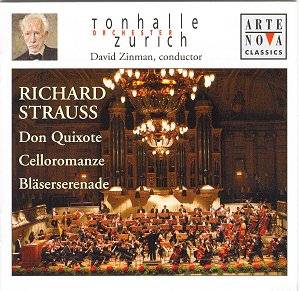This Arte Nova series of Strauss recordings,
of which the current disc is Volume 7, has been receiving glowing
reviews in the musical press so I approached this disc with keen
anticipation. It is the first I have heard in this budget priced
series. I was not disappointed. All three works are played with
a sensitivity that is quite rare in this day and age. Also, the
whole of Arte Novaís production is absolutely beyond criticism,
what with full recording details, total list of participants,
both in the orchestra for each work, plus the technical team and
short, but none the less informative, notes about both works and
artists. All of this at a budget price. It proves it can be done,
and other manufacturers should sit up and take note. This is a
disc that puts many full price issues to shame.
So what about the artistic merit of the performances.
David Zinman and his beautiful sounding orchestra have the full
measure of these famous and not so well known works of Richard
Strauss. There is a glow to the acoustic captured by the recording,
which enhances the orchestral palette, and increases our enjoyment
without there being excessive echo to cloud the detail.
My over-riding impression of this performance
was that of gentleness. In other words there are none of the big
gestures of the Herbert von Karajan variety, nor the range of
orchestral colours brought into play by the Berlin Philharmonic.
Another performance of Don Quixote which I have been listening
to recently is that of a live relay given in October 1967 by the
Cleveland Orchestra under George Szell. Here, as you might expect,
the Don is picked up by the scruff of the neck and hung out to
dry. It is about as far removed from David Zinmanís performance
as can be imagined. It is no less relevant but shows very clearly
how orchestral styles of playing have changed over the thirty
year period.
From 1897 onwards, Strauss was considered to
have entered his mature phase and was considered to be the most
famous composer of symphonic tone poems n existence. With Don
Quixote, he surpassed himself, for not only is it a symphonic
tone poem, it is also a concerto with the Don being assigned to
the cello and Sancho Panza the viola, euphonium and bass clarinet.
Most of the elements of Cervantesí story are covered as separate
elements in the work. Each of these is separately banded on the
disc, thus allowing us to follow the action easily. Arte Novaís
production is excellent as at every turn there is an element which
has been thought of to make the listenerís experience that much
better.
The two other works on the disc are relatively
early; almost student works. The Serenade for Winds shows Straussís
mastery of the wind colouring, even at such an early age. Hans
von Bülow, who originally thought that some of Straussís
early compositions were immature and precocious, and that the
composer was "no geniusÖbut at best talented", was very
impressed with the Wind Serenade. He supported the first performance
of the work, given by the Dresden Court orchestra. As a result,
von Bülow commissioned another Serenade from Strauss - his
later Suite for Winds Op. 4.
The Romance for Cello and Orchestra, which is
an early work, certainly doesnít sound early, showing as it does
a mastery of dealing with the material. It is superbly played
and I enjoyed it very much. Highly recommended.
John Phillips
